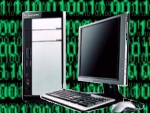



 |
Lesson 7: History - part 1 | part 2
1623 1820 1835 1890 1938 1941 1964
|
[......] Computers join the second world war. The Colossus computer is developed in great secrecy to break German codes. It is programmable, though it takes a lot of time and effort. Though the Colossus is the most advanced computer of its day, it does not lead to the development of further computers, because all Colossus computers are completely destroyed after the war, and their existence is kept secret until the 1970s. [......] Soon afterward the British inventor and engineer Charles Babbage comes up with the idea for a computer he calls the analytical engine. This is the world's first programmable computer. It is to work with steam power and use gears to reproduce many of the functions that the Chinese have been doing for centuries on the abacus. The design is too advanced for the engineering of the day and the machine is not built until 1991 when it is proved that Babbage's design was correct. It is now in the London Science Museum. [......] IBM Launch a series of computers capable of running different languages, multiple programs, and the ability to handle different kinds of data. This is the first machine to be sold in large numbers to businesses. Though they are still massive, very expensive, and extremely limited compared to the machines of 50 years later, they represent the birth of the modern computer industry. [......] Wilhelm Schickard builds the first mechanical calculator. This uses a system of gears and so much of the watchmaker's technology that his machine is called 'the calculating clock'. This machine represents the dawn of the computing era, and is immediately put to use by the astronomer Johannes Kepler who uses it to make major advances. [......] A businessman called Hollerith designs a system to sort out the data from the United States Census Bureau. The machines, developed to process the data became the main product of his company, International Business Machines, or IBM. Like Babbage's failed invention, IBM uses cards with holes in them to hold data, a system that remains in use for most of the next century. [......] The next major step forward comes 200 years later with the Thomas Arithmometer. It is based on the work of the scientist Leibnitz who worked out the binary system which is now used by every computer. The Arithmometer can add, subtract, multiply and divide, and is therefore the first mechanical calculator to be widely used. [......] The Atanasoff Berry Computer is developed in Iowa State University for solving linear equations. It uses binary as its mathematical system, and is powered by electronic circuits and 300 vacuum tubes. Though it is not programmable, it is the first recognizably modern computer. |
|